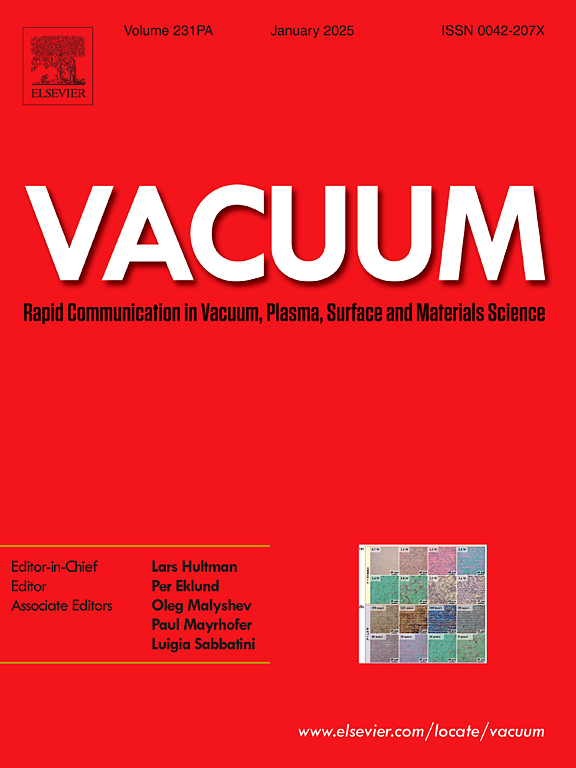V浓度对Ti1-xVxN薄膜x射线吸收边、光力学和抗腐蚀性能的影响
IF 3.8
2区 材料科学
Q2 MATERIALS SCIENCE, MULTIDISCIPLINARY
引用次数: 0
摘要
在室温下,通过直流磁控溅射合成了Ti1-xVxN薄膜(~ 150 nm),用于潜在的硬涂层和电化学应用。钒浓度的增加导致声子约束效应,拉曼模式的蓝移证明了这一点。EDX和XPS元素分析表明,Ti和V的浓度在7.42 ~ 47.37 at之间。%和13.77-45.13 at。%,氮含量接近恒定。Ti -edge XAS证实了氧空位导致的键键减弱(Ti - o, Ti - n和Ti - v),导致高v含量下硬度降低。Ti0.75V0.25N和Ti0.5V0.5N薄膜的硬度和弹性模量分别达到最高的15.14 GPa和161.11 GPa。电化学测量结果表明,Ti0.5V0.5N表现出最好的性能,比电容为24.29 mF/cm2,电极电阻低至93.13 Ω,表明离子传输性能优越。VN薄膜的电荷转移电阻最低(0.61 Ω),具有较高的电导率。腐蚀分析表明,随着V含量的增加,腐蚀速率从0.0002逐渐增加到0.0153 mm/年,这表明V虽然提高了电导率和电容,但却降低了耐腐蚀性。这些发现为平衡Ti1-xVxN涂层的机械完整性、电化学性能和耐腐蚀性建立了最佳的V浓度窗口。本文章由计算机程序翻译,如有差异,请以英文原文为准。
Effect of V concentration on X-ray absorption edge, opto-mechanical, and anti-corrosion properties of Ti1-xVxN thin films
Ti1-xVxN thin films (∼150 nm) were synthesised via DC magnetron sputtering at room temperature for potential hard-coating and electrochemical applications. Increasing vanadium concentration led to a phonon confinement effect, evidenced by a blue shift in Raman modes. Elemental analysis via EDX and XPS showed Ti and V concentrations ranging from 7.42 to 47.37 at.% and 13.77–45.13 at.%, respectively, with near-constant nitrogen content. Ti L-edge XAS confirmed bond weakening (Ti–O, Ti–N, and Ti–V) due to oxygen vacancies, contributing to reduced hardness in high-V content. The highest hardness (15.14 GPa) and elastic modulus (161.11 GPa) were achieved in Ti0.75V0.25N and Ti0.5V0.5N films, respectively. Electrochemical measurements revealed that Ti0.5V0.5N exhibited the best performance, with a specific capacitance of 24.29 mF/cm2 and a low electrode resistance of 93.13 Ω, indicating superior ion transport. VN films showed the lowest charge transfer resistance (0.61 Ω), reflecting high conductivity. Corrosion analysis showed a progressive increase in corrosion rate from 0.0002 to 0.0153 mm/year with increasing V content, indicating that while V enhances conductivity and capacitance, while compromises corrosion resistance. These findings establish an optimal V concentration window for balancing mechanical integrity, electrochemical performance, and corrosion resistance in Ti1-xVxN coatings.
求助全文
通过发布文献求助,成功后即可免费获取论文全文。
去求助
来源期刊

Vacuum
工程技术-材料科学:综合
CiteScore
6.80
自引率
17.50%
发文量
0
审稿时长
34 days
期刊介绍:
Vacuum is an international rapid publications journal with a focus on short communication. All papers are peer-reviewed, with the review process for short communication geared towards very fast turnaround times. The journal also published full research papers, thematic issues and selected papers from leading conferences.
A report in Vacuum should represent a major advance in an area that involves a controlled environment at pressures of one atmosphere or below.
The scope of the journal includes:
1. Vacuum; original developments in vacuum pumping and instrumentation, vacuum measurement, vacuum gas dynamics, gas-surface interactions, surface treatment for UHV applications and low outgassing, vacuum melting, sintering, and vacuum metrology. Technology and solutions for large-scale facilities (e.g., particle accelerators and fusion devices). New instrumentation ( e.g., detectors and electron microscopes).
2. Plasma science; advances in PVD, CVD, plasma-assisted CVD, ion sources, deposition processes and analysis.
3. Surface science; surface engineering, surface chemistry, surface analysis, crystal growth, ion-surface interactions and etching, nanometer-scale processing, surface modification.
4. Materials science; novel functional or structural materials. Metals, ceramics, and polymers. Experiments, simulations, and modelling for understanding structure-property relationships. Thin films and coatings. Nanostructures and ion implantation.
 求助内容:
求助内容: 应助结果提醒方式:
应助结果提醒方式:


